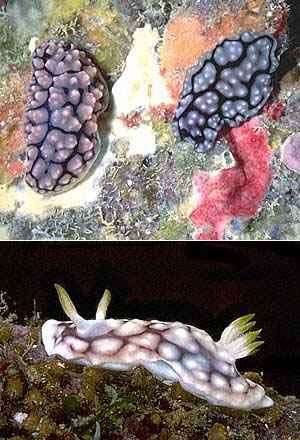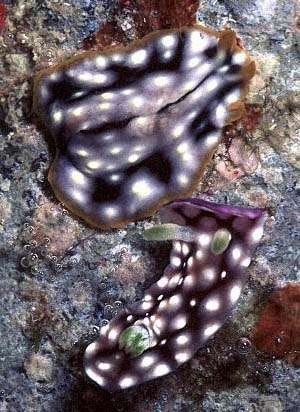

Mimicry
PHOTO
(UPPER) The nudibranch Phyllidiella pustulosa (left) and the turbellarian flatworm Pseudoceros imitatus (right).
Photo: L.Newman & A.Flowers. Heron Island
(MIDDLE) Chromodoris geometrica, Coffs Harbour Region, northern New South Wales, December 1990. Photo: Bill Rudman.
(LOWER:) Chromodoris geometrica and flatworm mimic from Philippines. Photo: Michael Miller.
RELATED TOPIC
There are many examples of animals which have evolved to look almost identical to another animal. There are spiders which look like ants, flies that look like wasps, harmless butterflies which look like poisonous butterflies, and many more. We call this mimicry, and usually one animal is considered to be the model and the other to me the mimic. In most cases which have been studied the mimic gains an advantage. For example, if a tasty animal looks like a poisonous one it is less likely to be eaten, and at the other extreme, if a dangerous animal looks like a harmless one, it can creep up on its prey without raising an alarm.
The example I illustrate here are the phyllidiid dorid nudibranchs such as Phyllidiella pustulosa. The phyllidiids exude very noxious and toxic chemicals from their skin and appear to be avoided by most fish. They are often the only sea slugs which blatantly crawl out in the open during the day. Other nudibranchs, flatworms, and even a holothurian are known to mimic phyllidiid nudibranchs.
See also:
Colour in sea slugs, red-spotted chromodorids in southeasterb Australia, Aposematism, three pages where aposematism and colour pattern mimicry are described.
• Discodoris? liturata, an almost perfect mimic of Phyllidiella pustulosa.
• Aldisa erwinkoehleri, an equally amazing mimic of Phyllidia.
• Doris? sp. 3, an equally amazing mimic of Phyllidiopsis.
• Aldisa williamsi, another phyllidiid mimic from Indonesia.
Rudman, W.B., 2004 (July 23) Mimicry. [In] Sea Slug Forum. Australian Museum, Sydney. Available from http://www.seaslugforum.net/factsheet/mimicry
Related messages
-
Holothurian phyllidiid mimic
From: Valérie Besnard, May 18, 2005 -
Flatworm mimic of Chromodoris magnifica
From: Mary Jane Adams, January 19, 2004 -
Bohadschia / Pearsonothuria
From: Bob Bolland, January 8, 2004 -
Bohadschia graffei as mimic of Phyllidia varicosa
From: Rosalind Day, October 17, 2003 -
Re: Phyllidia varicosa mimic
From: Marina Poddubetskaia, March 24, 2003 -
Phyllidia varicosa mimic
From: Rosalind Day, November 15, 2002 -
Phyllidia mimicry
From: Erwin Köhler, May 18, 2002 -
Why do some nudibranchs share the same colour patterns?
From: joe, March 13, 2002 -
Nudibranch & Flatworm mimicry
From: Adam Brown, March 5, 2002 -
Is this fish a Sea Slug Mimic?
From: Mark McGrouther , May 2, 2000 -
Holothurian Phyllidia mimic
From: Wolfgang Seifarth, December 21, 1999 -
About Mimicry & flatworms
From: Christine, July 11, 1999 -
Mimicry topic continued
From: Michael D. Miller, April 15, 1999 -
Mimicry revisited
From: Mike Miller, April 7, 1999 -
Mimicry: Flatworm & C. geometrica
From: Michael Miller, January 15, 1999 -
More Phyllidiella mimic pics
From: Michael Miller , December 3, 1998 -
A case of mimicry
From: Wayne Ellis, June 25, 1998
